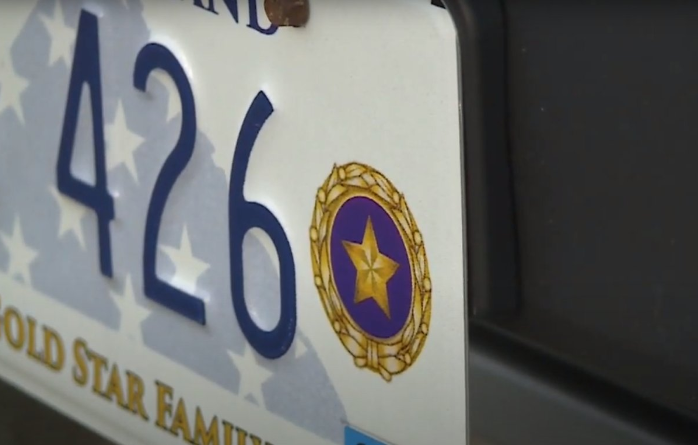Gold Star license plates are more than just a design on a vehicle—they represent a deep and poignant symbol of honor, sacrifice, and national pride. These plates signify that the driver or their family has lost a loved one in military service. But how did this symbol come to be, and what does it mean to those who display it? Let’s explore the history and significance of Gold Star license plates.
A Symbol of Sacrifice: What Do Gold Star License Plates Represent?

A Gold Star on a license plate signifies the loss of a family member who served in the military and died in the line of duty. It’s a simple yet powerful visual statement, acknowledging the bravery and ultimate sacrifice of service members. For the families who display these plates, they serve as a public tribute to loved ones who put their lives on the line for their country.
While the plates may look like standard designs to some, they carry immense emotional weight for Gold Star families. Each plate is a reminder of a fallen hero and serves as a way for the public to recognize and honor the sacrifices of military families.
Origins of the Gold Star Tradition
The Gold Star tradition finds its roots in World War I, specifically starting with the Blue Star Service Banner in 1917. Army Captain Robert L. Queisser, a member of the Ohio 5th Infantry, created the Blue Star Service Banner to honor his sons and other military members fighting in the war. The banner featured a blue star on a white background bordered by red, symbolizing active-duty service members.
This emblem quickly spread across the United States, symbolizing family members serving overseas. It provided a visual marker of patriotism and support during a time of uncertainty and conflict. The Blue Star symbolized hope and pride, but as the war progressed, the need for a distinct symbol to honor fallen soldiers became evident.
From Blue Star to Gold Star: Evolution of a Symbol
As the number of fallen soldiers grew during World War I, a more specific symbol of sacrifice emerged. The Women’s Committee of the Council of National Defense suggested that mothers of deceased soldiers wear a black armband adorned with a gold star. In 1918, President Woodrow Wilson approved the use of the gold star to represent those who died in service.
The gold star became an enduring symbol of loss and sacrifice, a transformation from the Blue Star’s representation of active service to the Gold Star’s memorial for the fallen. It provided a solemn yet respectful way for families to show their grief and honor their loved ones. The transition from blue to gold marked not just the passing of a life but also the enduring legacy of heroism.
The Birth of American Gold Star Mothers, Inc.
In 1928, a group of 25 grieving mothers, led by Grace Darling Seibold, formed American Gold Star Mothers, Inc. Seibold, whose son George was killed in World War I, felt compelled to support mothers like herself. The organization not only provided emotional support but also advocated for recognizing the ultimate sacrifice of fallen service members.
Through their efforts, the Blue Star Service Banner evolved to include gold stars, allowing families to commemorate the loss of their loved ones more visibly. Over the years, American Gold Star Mothers, Inc., has played a pivotal role in keeping the tradition of the Gold Star alive, ensuring that the sacrifices of military families are recognized and remembered.
Gold Star Mother’s Day: A Day of Honor and Remembrance
In 1936, the U.S. Congress officially established the last Sunday of September as Gold Star Mother’s Day. This day is set aside to honor the mothers who lost their sons and daughters in military service. It serves as a reminder that behind every fallen soldier is a grieving family, and it encourages the nation to acknowledge the sacrifices of these families.

The observance of Gold Star Mother’s Day has since expanded to include Gold Star Family Day, recognizing all family members who lost someone in the line of duty. This day of remembrance brings attention to the grief and resilience of those left behind, providing a platform for sharing stories of heroism and sacrifice.
Getting a Gold Star License Plate: Who is Eligible?
Gold Star license plates are available in many states across the U.S., but eligibility varies by location. Typically, these plates are reserved for immediate family members of fallen service members, including:
- Parents (Gold Star Mothers and Fathers)
- Spouses
- Siblings
- Children
In some states, eligibility extends to grandchildren and other close relatives. The application process usually requires proof of the applicant’s relationship to the deceased service member, along with documentation of the service member’s death in the line of duty.
The design of Gold Star license plates varies by state, but they often feature the iconic gold star symbol prominently, along with phrases such as “Gold Star Family” to clarify their purpose.

The Legacy of the Gold Star Tradition
The Gold Star tradition, rooted in the Blue Star Service Banner, has evolved into a solemn yet powerful reminder of the sacrifices made by military families. For those who have lost loved ones in service, displaying a Gold Star license plate is more than just a way to honor the deceased; it’s a personal testament to their loved one’s bravery and dedication.
Organizations like American Gold Star Mothers, Inc. continue to play a crucial role in preserving this legacy. They work tirelessly to support grieving families and ensure that the stories of fallen heroes are not forgotten. The tradition of the Gold Star serves as a constant reminder of the true cost of freedom and the sacrifices made by military families.
Conclusion: A Symbol of Honor, Sacrifice, and Memory
Gold Star license plates are not just a design; they represent a family’s profound loss and the country’s collective gratitude. They stand as a public tribute to the courage and sacrifice of those who gave everything for their country, while also honoring the strength of the families left behind.
The tradition of the Gold Star, from its origins in the Blue Star Service Banner to the present-day license plates, carries a deep legacy of honor, patriotism, and remembrance. As you drive past a vehicle displaying a Gold Star plate, remember the story behind it—a story of sacrifice, resilience, and enduring love for both family and country.